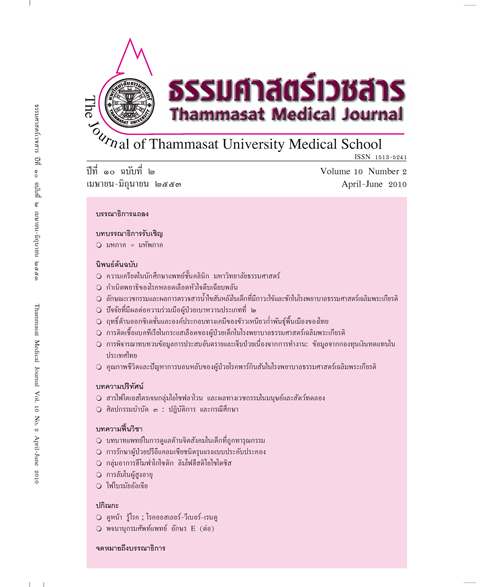Bactermia in pediatric patients in Thammasat University Hospital
Keywords:
Bactermia, ChildrenAbstract
Background: Bacteremia is a life-threatening condition. Delayed treatment of this condition may lead to sepsisor septic shock which increase mortality in children.
Objectives: To study epidemiological data, causative agents, and antibiotic susceptibility in pediatric patientswith bacteremia at Thammasat University Hospital.
Methodology: A retrospective study was conducted for patients, aged between 1 month and 15 years,diagnosed with bacteremia at Thammasat University hospital between January 2002 andOctober 2008.
Results: The sample group was 38 children with bacteremia. Bacteremia mostly occurred in infants aged1 month to 1 year (57.9%). They acquired infection in the community more than in the hospital(73.6% and 26.4% respectively). Most children (84.2%) had a focal site of infection. Respiratorytract infection (26.3 %) and urinary tract infection (18.4%) were most common found. 71.1% ofchildren had a fever higher than 39 ÌC. In 44.7% of patient had white blood cell more than15,000 cells/cumm. Ten percent of infants and 56.3% of children aged more than 1 year hadunderlying disease. Two children (5.3%) who had underlying disease died with gram negativeseptic shock. Gram negative bacteria were isolated more frequently than gram positive bacteria(73.6% vs 26.4%). Among the gram negative bacteria E. coli and K. pneumoniae were thepredominant group, followed by Enterobacter spp. These organisms were susceptible to amikacin(100%), gentamicin (67-86%), cefotaxime (67-86%) and ampicillin (0-33%). In this study, theisolated gram positive bacteria included S. aureus, S. pneumoniae and S. viridans. Sixty sevenpercent of S. pneumoniae was susceptible to penicillin.
Conclusion: In children, bacteremia mostly occurred in infants and caused by community acquired gramnegative infections. The common gram negative organisms were highly susceptible to amikacinbut resisted to ampicillin. The relatively this study should alert pediatrician to aware of bacteremiain infant without underlying diseases.
Key words: Bactermia, Children



